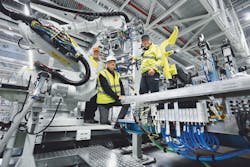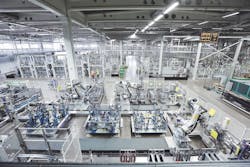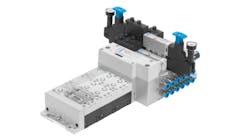Scania Automates for Mass Production of Customized Truck Cabs
With the help of 288 robots, truck body maker Scania has automated 95% of its body shop in Oskarshamn, Sweden. Though highly automated for mass production, the plant’s automation technology also supports extensive customization. By the time these truck cabs reach the end of the assembly line, virtually no two truck cabs are the same.
Scania is able to do this by approaching its automation strategy from an Industrial Internet of Things (IIoT) point of view, supported by automation products from Festo. Scania, a Volkswagen Group company, has been using robots to assemble customized truck cabs to order in Oskarshamn since 2016. Once the cabs are manufactured, vehicle transporters deliver them to the Scania assembly plants in Sodertalje near Stockholm, Zwolle in the Netherlands and Angers in France, where they are assembled to create a finished truck chassis.
Swedish occupational health and safety regulations have made it impossible to use hand-held welding equipment. These regulations evolved as welding tools became too heavy and unwieldy for humans to handle. In addition, safety directives require a minimum distance between the welding gun and the operator because of radiation. As a result, robots now place the truck panel parts on joining stations and weld them. Employees are responsible for loading the stations and monitoring the machines.
The banning of manual welding from the assembly workshop has benefitted Scania in two ways— better processes and quality, says Lars Kreutner, project leader, cab body production at Oskarshamn.
To make full use of its automation technology, Scania has set up a training division where employees learn how to use the robots and automation technology.
IIoT enables extensive customization
All the trucks that Scania builds weigh more than 16 tons. Many of these special vehicles are used for fire services or waste collection, for example. These niche markets alone account for hundreds of thousands of variants.
The Scania factory has many key features associated with the IIoT, such as mass production of customized vehicles, adaptability and flexibility thanks to control technology, diagnostic capabilities, and industrial energy efficiency and safety solutions. A key aspect of Scania’s IIoT approach involves the modularity of automation technology.
Modular standardization for manufacturers is critical, explains Forsberg because “plant operators need to be able to rely on proven automation products and avoid unnecessary stocking of spare parts.”
Festo’s CPX automation platform
The Scania plant uses pneumatically actuated devices to clamp truck cab panel parts and weld them. Welding robots require compressed air to move the welding guns and clamp the metal sheets. Cooling water protects the welding systems against overheating.
Scania uses Festo systems for supplying compressed air and cooling water for the welding guns. At the Scania plant, these systems are integrated into the safety fence for ease of operation.
The valve manifold provides diagnostic data via the CPX automation platform and can be used to monitor the system as part of predictive maintenance “We can replace components before they fail and paralyze entire parts of the system,” says Kreutner.
“We were also impressed by the valve manifold’s safety concept,” explains Forsberg. “The CPX makes it possible to operate different pressure zones and to exhaust areas when intervention is required. We can check affected system parts using mobile panels and don’t have to search the entire system for errors, which can be like looking for a needle in a haystack. And re-pressurizing individual system parts is much more energy efficient than starting up the entire system.”
Because the welding gun electrodes become blunt as they are used, they have to be milled to ensure spot welding is consistently accurate. Festo developed a pivoted arm to Scania’s and ABB’s specifications to bring an electrode milling device to the welding gun electrodes after 150 spot welds have been completed. The pivoted arm is precisely positioned by Festo DNCE electric cylinders and powered by a Festo EMMS stepper motor. Using this combination of technologies made it possible for Festo to cut milling cycle times by more than half.
The Festo control cabinet for electrode milling comprises the CMMS (computerized maintenance management system), motor controller and the CPX platform, which communicates with the motor controllers and the primary robot controller.
Safety has increased as result of using this system, “since plant operators no longer have to enter the robot cells after milling to adjust the electrodes to the correct position for the spot welds,” explains Leif Lindahl, former key account manager for Scania at Festo.
The Oskarshamn factory has set a precedent for Scania, which plans to build a similar factory in Sao Paulo, Brazil.
About the Author

Leaders relevant to this article:


